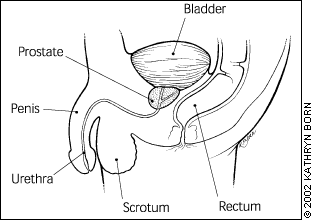
Am Fam Physician. 2002;66(1):87-74
What is the prostate?
The prostate is a gland that makes the fluid in semen. It is located under a man's bladder and wraps around his urethra (see drawing below). The urethra is the tube that carries urine from the bladder through the penis to the outside of the body.

What is BPH?
As men get older, the prostate gland slowly gets bigger. It may press on the urethra and cause urine to flow slower and with less force. This condition is called BPH, which stands for benign prostatic hyperplasia (say: bee-nine pros-ta-tick high-pur-play-shah).
What are some signs of BPH?
When you first get BPH, you might have no signs. After a while, you might start to have some of these signs:
Trouble starting to urinate
Feeling the need to urinate often
Dribbling after you think you have finished urinating
Needing to get up more often in the night to urinate
Decreased force of your urine stream
Tell your doctor if you have any of these signs. Other problems, like an infection or cancer, can also cause these signs.
If I have signs of BPH, what will my doctor do?
Your doctor will ask questions about your urine flow. You will have a rectal exam to check the size of your prostate. During this exam, your doctor will also feel for other prostate problems.
Your urine might be checked for blood or infection. You might have a blood test to see if your kidneys are working right. You might also have other tests.
What can I do if I have BPH?
Here are a few things you can do:
Give yourself time to urinate completely.
Do not drink alcohol, drinks with caffeine in them (coffee, tea, colas), or other fluids in the evening.
Do not take decongestants like pseudoephedrine (example of a brand name: Sudafed).
Do not take antihistamines like diphenhydramine (example of a brand name: Benadryl).
How is BPH treated?
Your doctor might have you wait and see if your urine flow gets better by itself.
Some men with BPH take an herbal medicine made with saw palmetto. Saw palmetto might not work as well as regular medicines, but it has fewer side effects.
Your doctor might have you take a blood pressure medicine called an alpha blocker. This medicine will cause the muscles of your urethra to relax. Because the alpha blocker lowers your blood pressure, it can make you feel tired or sleepy. Some alpha blockers are terazosin (brand name: Hytrin), prazosin (brand name: Minipress), and doxazosin (brand name: Cardura).
Tamsulosin (brand name: Flomax) is a newer alpha blocker. It has little, if any, effect on blood pressure.
Your doctor might have you take finasteride (brand name: Proscar). This medicine makes the prostate gland become smaller. Finasteride works more slowly than alpha blockers. It can also cause impotence or lack of sexual desire. Or, your doctor might have you take dutasteride (Duagen), a new medicine that is similar to finasteride.
BPH can get bad enough that you cannot urinate much—or at all. If this happens, a tube is put into your urethra to empty your bladder. This tube is called a catheter. The catheter is usually left in for a week or two. Sometimes the problem happens again when the catheter is taken out. Then you might be given a treatment to shrink or remove prostate tissue.
Is BPH treated with surgery?
If BPH becomes a big problem, you might need surgery. The most common surgery for BPH is called TURP (this stands for transurethral resection of the prostate). This surgery is done through the urethra.
After TURP, you have a small chance of having other problems. Some of these problems are incontinence (poor control of urination), bleeding, infection, and impotence (inability to have an erection). Movement of semen into the bladder, instead of out the penis, can happen after TURP. This problem is called retrograde ejaculation. Sometimes the prostate grows back, and signs of BPH happen again.
BPH can also be treated with newer surgeries that use heat, microwaves, or laser beams to remove prostate tissue. How well these surgeries work is not yet fully known.
Your doctor will help you decide what treatment might be best for you.